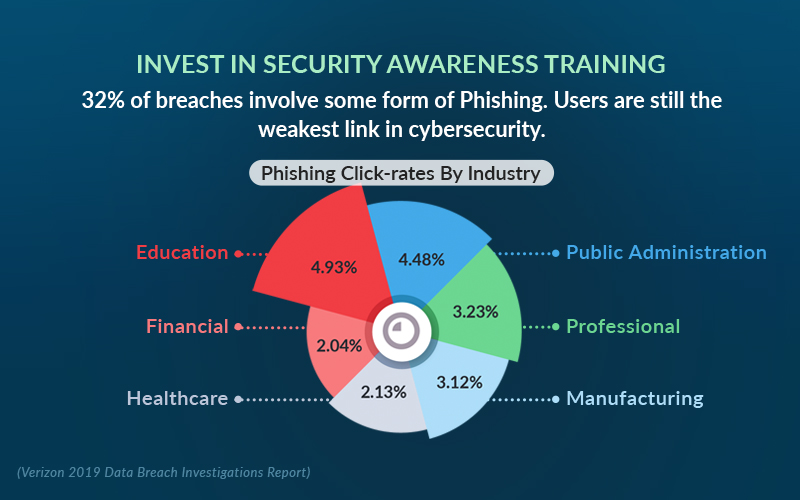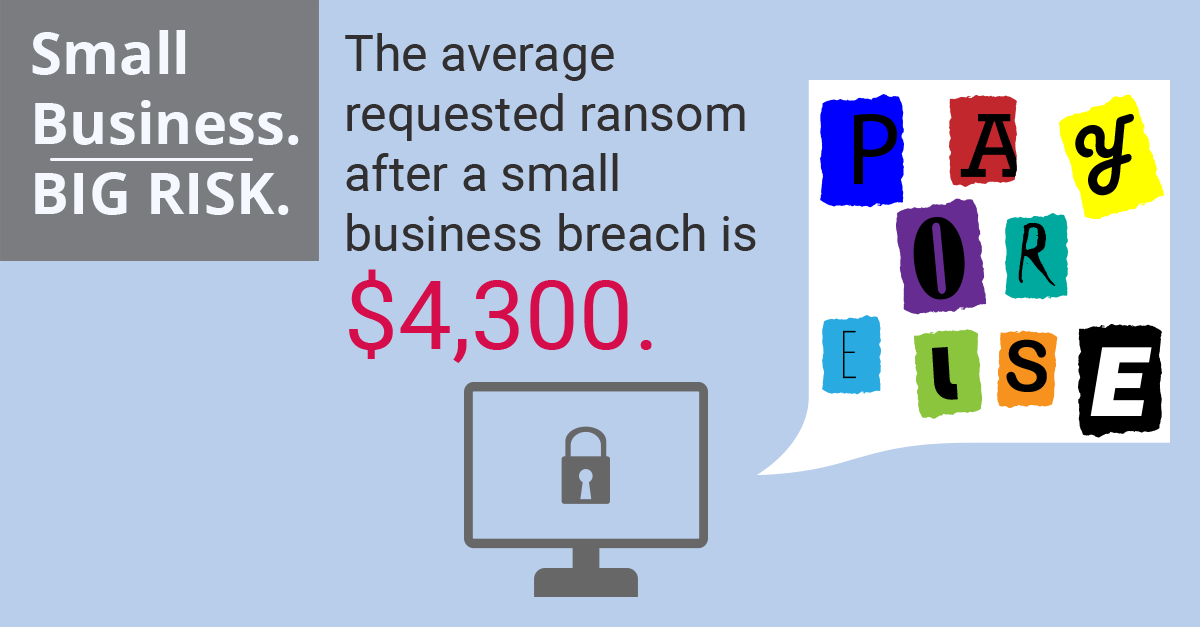A Guide to Security Awareness Training for Businesses
Users are the weakest link in security — Do you have Cyber Security Awareness Training your Employees?
Security Awareness Training for Employees
Security awareness training for employees helps protect your business by teaching employees how to recognize and avoid cyber threats. This training covers topics like phishing scams, password safety, and safe internet practices. Regular training ensures your team is aware of the latest threats and knows how to respond, reducing the risk of data breaches and cyberattacks.
What Is Security Awareness Training
Cybersecurity awareness training for employees is a process for educating employees about how to protect themselves and your company from attacks.
Security Awareness Training consists of two major components. The first is cyber security awareness training courses. Online security awareness training is a proactive approach to prepare employees for cyberattacks they are most likely to face. A security awareness program includes computer-based training modules, interactive exercises and assessments covering the core cybersecurity topics each employee should be familiar with.
The second component of Information Security Training is simulated phishing training. Simulated phishing awareness training programs deliver realistic email templates to employees to see how they behave when a phishing email hits their inbox. Employees who click a phishing email or reveal sensitive information are delivered training in real-time to help them avoid phishing attacks in the future.
A good cybersecurity awareness training program should educate employees about corporate policies and procedures for working with information technology (IT). Employees should receive information about who to contact if they discover a security threat and be taught that data as a valuable corporate asset. Regular training is particularly necessary in organizations with high turnover rates and those that rely heavily on contract or temporary staff. Confirming how well the awareness program is working can be difficult. The most common metric looks for a downward trend in the number of incidents over time.
Even though it may not be required by small and medium businesses for compliance reasons, they can benefit from training their employees to avoid cyber incidents through phishing attacks, account takeovers, or other well-known means that cybercriminals use to steal company assets.
61%
of businesses reported a cyberattack in the last year — does your business have a cyber readiness plan?
Why Security Awareness Training Is Important
For many businesses, technology is moving faster than their ability to keep their business secure. 63% of professionals report they don’t have enough security training to keep up with risks and for the third year in a row, the percentage of security incidents attributed to human error is on the rise. With the rate of learning falling behind the pace of technology change, employee security education remains one of the most critical layers of security defense available to your organization today.

What Is the Main Purpose of Security Awareness Training?
A security awareness training solution should be designed to meet three key objectives:
- Educate employees and motivate behavior change with Security Awareness Training. Training should include industry- and role-based training resources to help deliver engaging, relevant training to every member of your organization.
- Empower employees to detect and report phishing attacks. Building simulated phishing campaigns to teach employees how to avoid the most dangerous phishing threats they face.
- Track compliance, assess security risk and prove training success. We recommend starting with a base line. A training platform should make it easy to track and share your organization’s compliance score and phish rate. The platform’s pre-built reports and charts should help you identify behavioral trends over time and prove the success of your program at the organization, department and individual learner level.

Methodologies to meet these objectives include:
- Training content should be mapped to the National Institute of Standards and Technology (NIST) cybersecurity framework.
- Reporting, analytics and security assessments to quantify training impact and detect employee-related risks before breaches occur.
- Ongoing support in program implementation and design, execution and reporting.
Why Security Awareness Education and Training Is Important Within Organizations
The vast majority of cyberattacks happen to small and medium-sized businesses. In fact, 60% of small businesses fold within six months of a cyberattack. For organizations that have experienced a data breach or ransomware attack, the benefits of security awareness training couldn’t be more clear. But for organizations that only run Security Awareness Training to remain compliant, or businesses/security teams that have never run an employee training program, the benefits may seem abstract. With many organizations facing understaffed IT and security departments with limited time and budget, it’s smart to ask, “Do the benefits of Security Awareness Training outweigh the costs?”.
Obviously, Security Awareness Training does not generate revenue. Instead, financial gain is measured as the dollar value saved as a result of reduced cyber risk.
Running a layered awareness and training program and building a culture of cybersecurity at your organization takes planning and coordination but it doesn’t have to be hard.
Verity IT offers a number of Security Awareness Training options.
According to Osterman Research, employees who receive Security Awareness Training are significantly better at recognizing security threats than those who have not received training.
Furthermore, with 32% of breaches involving phishing attacks (which are often indefensible by security tools) it is no surprise that NIST recommends Security Awareness Training for every organization.
Is Free Security Awareness Training Okay for My Business?
I think we all know the answer here. Your most important asset is probably your business, followed closely by your employees. The ROI from investing in a security training and threat awareness program is a no brainer. So why go with free, when we know that free is not going to provide you with the right education, tools and reports to protect your most important asset.
When It Comes to Security, USERS Are the Weakest Link — Are You Training Your Team to Recognize Cyberthreats?
How to Train Employees on Cybersecurity
It’s tempting to picture a perfect Cyber security awareness program that ensures your workforce never clicks on a suspicious link or downloads a malicious attachment but it’s important to remember that security awareness is not an all-or-nothing effort. When building your human firewall through Security Awareness Training, incremental gains are important. Following a few best practices can help you stack your incremental gains and strengthen your human firewall.
- Don’t just aspire for security awareness. Inspire the behavioral change required to keep your organization safe from security threats. While ability is the first step towards behavioral change, your workforce must be motivated to turn security best practices into routine action. Even simple gestures such as sharing what interests you about security, incentivizing the right behaviors and celebrating moderate gains can motivate your workforce and inspire behavioral change.
- What is the right message, when should you send it and through what channels? Focus on the frequency of messaging, the relevance of your information and the engagement of your content.
- Top-down support is important for security awareness success. Communicate your efforts to executives in the most effective way. Executive support is an important factor in ensuring the long-term success of your security awareness efforts. When executives see security awareness as a core element of organizational success, it becomes easier to to prioritize and support your program.
- Inspect what you expect. Use all data at your disposal to track progress and measure the success of your security awareness efforts. When running a security awareness campaign, it is important to track training participation, phishing training success and assessment scores. Taking full advantage of your program metrics allows you to become more strategic and tactical with your program while giving you the data to demonstrate value to your organization.
- Annual, required security awareness training and one-off efforts don’t work. You need a dynamic roadmap to sustain security awareness momentum and behavioral change in the long term. Long-term behavioral change takes time to take hold. Plan your Security Awareness Program to span at least one year to keep security awareness top of mind and drive lasting behavioral change.
Don’t get caught by phishing scams!
Let’s set up defenses that actually work.
What Should a Security Awareness Program Include?
A successful security awareness program should cover key cybersecurity topics, provide practical training, and offer continuous education for employees. But how do you run an effective program, and what are the most important areas to focus on?
Using a well-established framework like NIST (National Institute of Standards and Technology) can help you build and mature your program. NIST provides comprehensive security guidelines to ensure your employees are equipped to recognize and respond to potential cyber threats.
What Is NIST?
The National Institute of Standards and Technology (NIST) is an agency within the United States Department of Commerce. NIST serves as the U.S. national laboratory, promoting innovation and industrial competitiveness in numerous industries by setting measurement standards, performing research and building organizational frameworks — including frameworks to help organizations structure and mature their Security Awareness Training Programs.
Security Awareness Training Topics
NIST Special Publication 800-50 recommends security awareness and training covering the following nine topics:
- Phishing
- Password security
- Safe web browsing
- Social engineering
- Malware
- Mobile security
- Physical security
- Removable media
- Working remotely
Although each of the core cybersecurity topics can be broken down into detailed sub-topics, this list serves as a foundational training recommendation for all employees and should be part of your small business IT Support.
Investing in security awareness training delivers a significant return on investment (ROI) by preventing costly data breaches and minimizing business disruption. According to a 2024 IBM report, the average cost of a data breach is $4.88 million. Comparatively, the cost of implementing phishing training programs is much lower, typically ranging from a few hundred to a few thousand dollars per employee. Training reduces the likelihood of incidents by teaching employees to recognize phishing attempts, weak passwords, and social engineering attacks, which often lead to breaches.
Cost Breakdown:
- Data Breach Costs: Data breaches can incur legal fees, penalties, loss of customer trust, and recovery expenses. Breaches often lead to downtime, which further affects revenue. For instance, a ransomware attack can cause downtime costing businesses an average of $1.85 million.
- Training Costs: Investing in ongoing employee education ranges from $300 to $3,000 per employee annually, depending on the provider and the depth of the training.
Key ROI Insights:
- Risk Reduction: By reducing the chance of breaches by up to 70%, training lowers the financial impact.
- Compliance: Many industries require security awareness programs for compliance (e.g., HIPAA, GDPR). Non-compliance fines far exceed the cost of training.
- Long-Term Savings: Trained employees are less likely to fall victim to phishing attacks or accidental breaches, saving the company money in the long term.
A well-structured cyber security training for employees can deliver measurable cost savings and risk reduction, while also improving your business resilience to phishing attacks and malware.
Get Your Free IT Cost Reduction Analysis
Identify Potential Savings with Our No-Obligation Assessment.
Security Awareness Training Best Practices
Security Awareness Training for Chicago Businesses
Security Awareness Training for Chicago Businesses How Cybersecurity Training Can Save Your Chicago Business from the Next Big Attack What is Security Awareness Training and Why is it Essential for Chicago Businesses? Security Awareness Training educates employees on how to…
Continue Reading Security Awareness Training for Chicago Businesses
The Role of Employees in Cybersecurity
The Role of Employees in Cybersecurity Empowering Your Team: Best Practices for Employee-Driven Cybersecurity In today’s world, cybersecurity is not just the responsibility of IT departments. Every employee plays a crucial role in safeguarding a company’s systems and data. The…
Employee Training to Prevent Phishing Attacks
Employee Training to Prevent Phishing Attacks A Critical Measure for SMBs Small and medium-sized businesses (SMBs) face an increasing number of cybersecurity threats. Among these, phishing attacks remain one of the most pervasive and damaging. According to the Verizon Data…
Continue Reading Employee Training to Prevent Phishing Attacks
What Is Ransomware? The Must-Knows.
What is Ransomware? Ransomware Explained: How It Works and How to Defend Against It What Is Ransomware and How Can You Defend Against It? Ransomware is a word no business wants to hear. It’s a type of malicious software designed…
7 Reasons Why Security Awareness Training Is Crucial
7 Reasons Why Security Awareness Training Is Crucial for Protecting Your Business The Power of Security Awareness Training: Protect Your Business from Cyber Threats Your employees—whether they’re at the office or working remotely—are often the first line of defense. Without…
Continue Reading 7 Reasons Why Security Awareness Training Is Crucial






